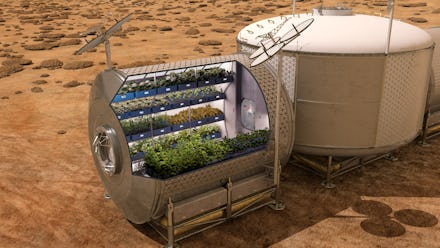Astronauts Are Eating Food Grown in Space for First Time — Here's Why That's a Huge Deal

On Monday, astronauts on the International Space Station will eat food they grew in space — 249 miles from the surface of Earth.
NASA announced Friday the team would finally get to eat the fruits of their labor (or in this case, the leafy greens of their labor) by serving up a plate of "Outredgeous" red romaine lettuce that has been growing in the Veggie plant growth system.
The system, developed by ORBITEC in Madison, Wisconsin, is the first open-air vegetable garden sent to the ISS, and it uses red, blue and green LEDs to grow the plants using a precise timing method, much like the giant vertical farms popping up around the planet currently.
The greens are grown in rooting "pillows," or single-use pods full of seeds that can be watered and harvested. Right now, the ISS is growing the red romaine and zinnias, which are testing the how well pollination works in zero gravity — and adding more to the morale of the station than the bellies of its residents.
"There is evidence that supports fresh foods, such as tomatoes, blueberries and red lettuce are a good source of antioxidants," Ray Wheeler, lead for Advanced Life Support activities in the Exploration Research and Technology Programs Office at Kennedy Space Center, said in a press release. "Having fresh food like these available in space could have a positive impact on people's moods and also could provide some protection against radiation in space."
What might be most exciting about this is why NASA wants to figure out ways to grow food in space. Veg-01, the Veggie system experiment's official name, is testing the potential for not only growing real, non-"astronaut food" nutrients on a space ship, but also for its potential in the Journey to Mars. Scientists, including Neil deGrasse Tyson, are skeptical of the potential of colonizing Mars because of the lack of essential vitamins and minerals.
But if a shuttle can land on the Mars surface and be converted into what's pretty much a walk-in hydroponic garden, future Red Planet researchers could have an abundance of fresh produce to pick from. And since the Veggie units are collapsible and expandable, it wouldn't be difficult to send a few of them to the planet's surface, keeping a constant stream of researchers from going hungry.
The space station isn't the only benefactor of this research, however. Proving the ability to grow in unnatural or infertile areas could be huge for people living on parched patches of the planet. Paul Zamprelli, business development director of ORBITEC, works with desert cities which are often too hot to do any real farming and have to import almost all of their fruits and vegetables from elsewhere.
"We're taking these same type of units like Veggie and burying them into the sand," Zamprelli told NASA in a video interview. "Big huge warehouses that they can then use the abundance of sun ... they have an abundance of water, but it's in a controlled environment, and they can start supplementing, just like the space station's going to do."
The Veg-01 experiment could mean we'll soon see floating space farms to help feed interstellar researchers, and even keep dehydrated countries from starving or spending their entire GDP on importing produce. This could be the game changer both Earth-bound and space-bound people have been waiting for.